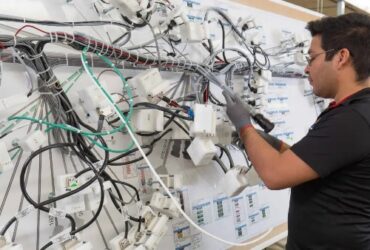Water is essential to life, and its quality plays a vital role in our overall well-being. However, not all water is created equal. Our modern lifestyle and industrial practices have led to the contamination and degradation of our water sources. This has prompted the development of various water treatment technologies, including structured water devices.
What are Structured Water Devices?
Structured water devices are tools that claim to enhance the quality of water by altering its molecular structure. They are designed to mimic the naturally occurring phenomenon of structured water found in pristine environments like mountain springs and waterfalls.
These devices typically utilize various methods such as vortexing, magnetic fields, or specific geometrical patterns to create a more organized and coherent arrangement of water molecules.
Proponents of structured water devices believe that this alteration of the water’s molecular structure can lead to several benefits. Firstly, they claim that structured water is more easily absorbed by the cells in our bodies, allowing for better hydration and nutrient absorption. Additionally, it is suggested that structured water has a higher energy potential, which can contribute to increased vitality and overall well-being.
Furthermore, structured water devices are said to improve the taste and quality of water. Supporters argue that the reorganization of water molecules can remove impurities, reduce the presence of harmful substances, and enhance the natural flavors of water.
It is important to note that while some anecdotal evidence suggests positive effects from using structured water devices, the scientific community remains skeptical. Many experts argue that the concept of structured water lacks sufficient scientific evidence and is based more on pseudoscience.
In conclusion, structured water devices claim to enhance the quality of water by altering its molecular structure to mimic the characteristics of pristine water sources. However, the scientific validity of these claims is still a topic of debate, and further research is needed to fully understand the potential benefits of structured water.
How Do Structured Water Devices Work?
The specific mechanisms behind structured water devices can vary depending on the design and technology used. However, they typically involve the following principles:
1. Ionization: Many structured water devices use ionization processes to alter the molecular structure of water. This can involve the use of magnets, electrical charges, or other methods to rearrange the water molecules into a more ordered and structured configuration.
2. Vortexing: Another common principle used in structured water devices is vortexing. This involves creating a swirling motion in the water to mimic the natural movement of water in streams and rivers. This movement helps to break up large clusters of water molecules and create a more uniform and structured arrangement.
3. Filtration: Some structured water devices incorporate filtration systems to remove impurities and contaminants from the water. This can include the use of carbon filters, ceramic filters, or other technologies to improve the quality of the water before it is structured.
4. Infusion of energy: Many structured water devices claim to infuse the water with beneficial energy frequencies. This can be done through the use of crystals, minerals, or other materials that emit specific vibrations or frequencies that are believed to have positive effects on the water molecules.
5. Resonance and coherence: Some structured water devices utilize resonance and coherence principles to align the water molecules and enhance their ability to carry and transmit information. This can involve the use of specific frequencies or vibrations that resonate with the molecular structure of water, promoting greater organization and structure.
It’s important to note that while these principles are commonly associated with structured water devices, their effectiveness and scientific validity are still a matter of debate and ongoing research. Different manufacturers may employ different technologies and claims regarding the benefits of their structured water devices.
The Science Behind Structured Water Devices
The scientific understanding of structured water devices is still evolving, and there is ongoing debate about their effectiveness. While some studies and anecdotal evidence suggest positive effects, the mechanisms behind structured water devices are not fully understood or widely accepted within the scientific community.
Structured water devices, such as water structuring units or water revitalizers, claim to improve the structure and properties of water molecules. These devices typically use various methods, such as vortexing, magnetic fields, or specific geometries, to alter the structure of water at a molecular level.
Proponents of structured water devices argue that they can enhance the hydration, absorption, and overall health benefits of water. Some studies have indicated that structured water may have improved solubility, increased bioavailability of nutrients, and better cellular function. Additionally, proponents claim that structured water devices can reduce scaling, improve plant growth, and enhance the taste and quality of water.
However, there is ongoing scientific debate surrounding structured water devices. Critics argue that the current evidence supporting their effectiveness is limited and inconclusive. Some studies have failed to find significant differences between structured water and regular water in terms of physical and chemical properties.
While anecdotal evidence and individual testimonies often highlight the positive effects of using structured water devices, the mechanisms by which they allegedly work are not well understood or universally accepted within the scientific community.
Some researchers suggest that any benefits attributed to structured water devices may be explained by more mundane factors, such as increased aeration or altered pH levels, rather than any unique structural changes to the water molecules themselves.
Further research and rigorous scientific studies are needed to establish a solid understanding of structured water devices and their potential benefits. Until then, the effectiveness of these devices remains a subject of controversy and skepticism among scientists and experts in the field.
Considerations and Criticisms
While structured water devices may have their proponents, there are also criticisms and considerations to keep in mind:
While structured water devices may have their proponents, with claims of improved hydration and detoxification, there are also criticisms and considerations to keep in mind. One major criticism is the lack of scientific evidence to support the claims made by these devices. Many of the studies conducted on structured water have been small-scale or poorly designed, making it difficult to draw definitive conclusions. Additionally, there is limited understanding of what exactly structured water is and how it differs from regular water.
Another consideration is the cost. Structured water devices can be quite expensive, ranging from hundreds to thousands of dollars. This may not be feasible for everyone, especially considering the lack of concrete evidence supporting their effectiveness. It is also important to note that the benefits attributed to structured water devices may simply be due to increased water consumption, which can be achieved without the need for expensive equipment.
Additionally, some critics argue that the concept of structured water goes against established scientific principles. The idea that water can be “structured” in a way that enhances its properties is not supported by mainstream science. Water molecules are constantly in motion, and any structure that may form is temporary and quickly dissipates.
Furthermore, relying solely on structured water devices for hydration may overlook other important aspects of a healthy lifestyle, such as a balanced diet and regular exercise. While proper hydration is important, it is just one piece of the puzzle when it comes to overall well-being.
In conclusion, while structured water devices may have their proponents, it is important to approach their claims with a critical mindset. The lack of scientific evidence, high cost, and questionable scientific basis should all be considered before investing in such devices. It may be more beneficial to focus on proven methods of staying hydrated, such as drinking adequate amounts of regular water and maintaining a healthy lifestyle.
In Conclusion
Structured water devices continue to be a topic of interest and debate. While they claim to enhance the quality of water through molecular restructuring, the scientific understanding of their mechanisms is not yet well-established. It is important to approach structured water devices with a critical mindset and consider the available scientific evidence before making any conclusions or investment.










